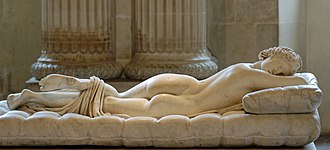| Sleeping Hermaphroditus | |
|---|---|
| The Borghese Hermaphrodite | |
 | |
| Artist | Unknown (sculpture); Gian Lorenzo Bernini (mattress) |
| Year | c. 100-500 AD (sculpture); 1620 (mattress) |
| Type | Sculpture |
| Medium | Marble |
| Subject | Hermaphroditus |
| Dimensions | 173.5 cm(68.3 in) |
| Location | The Louvre, Paris |
Sleeping Hermaphroditus or Sleeping Hermaphrodite (also, "The Borghese Hermaphrodite") is an ancient Roman marble sculpture depicting Hermaphroditus life size; it rests on a marble mattress completed by Italian artist Gian Lorenzo Bernini in 1620. [1] The form is derived from ancient portrayals of Venus and other female nudes, and from feminized Hellenistic portrayals of Dionysus. This subject was widely repeated during the Hellenistic period and in ancient Rome, given the number of versions that have survived.
Contents
- History
- Ancient copies
- Modern copies & inspirations
- See also
- References
- Notes
- Bibliography
- External links
The sculpture was discovered at Santa Maria della Vittoria in Rome in 1618 and became part of the Borghese Collection. It was sold to France at the end of the 18th century and is currently on display at The Louvre, in Paris. [1]
The Sleeping Hermaphrodite has been described as a good early Imperial Roman copy of a bronze original by the later of the two Hellenistic sculptors named Polycles (working c. 155 BC); [2] the original bronze was mentioned in Pliny's Natural History. [3]







